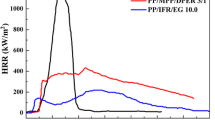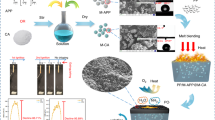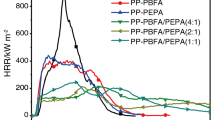Abstract
A hydrophobic, β-cyclodextrin-based and halogen-free flame retardant (MCDPM) with three components in an integrated structure has been prepared by a facile method. Three traditional intumescence flame-retardant components were chemically combined into one compound. The aim of this paper was to improve the dispersion and flame retardancy in polypropylene (PP) via introducing a mono-component biomass-based compound. The structure and properties of MCDPM have been systematically investigated. To prepare samples for flammability testing, MCDPM particles were introduced into polypropylene (PP) via melt blending. The thermal stability of the blend was dramatically greater than that of PP. Notably, the limiting oxygen index (LOI) for PP/30 phr MCDPM blend was 26.4% and the blends could pass UL-94 V-1 ratings, demonstrating that the flame retardancy of PP could be enhanced by introducing MCDPM. Through the systematic analysis of the char residue, a possible intumescent flame-retardant mode of action has been proposed.






Similar content being viewed by others
References
Gonzalez-Calderon JA, Pérez-Pérez C, Rodríguez RYP, Fierro-González JC, Vallejo-Montesinos J. Silanization of di-n-octyldichlorosilane as a route to improve the integration of titanium dioxide in polypropylene. J Therm Anal Calorim. 2019;138:1069–79.
Guo BY, Zhang TQ, Zhang WX, Dou YL. Influence of surface flame-retardant layer containing ammonium polyphosphate and expandable graphite on the performance of jute/polypropylene composites. J Therm Anal Calorim. 2019;135:2367–75.
Zheng ZH, Liu YH, Dai BY, Meng CY, Guo ZX. Fabrication of cellulose-based halogen-free flame retardant and its synergistic effect with expandable graphite in polypropylene. Carbohyd Polym. 2019;213:257–65.
Yang SQ, Bai SB, Duan WF, Wang Q. Preparation of composites based on recycled polypropylene and automotive shredder residue. Polym Int. 2018;67:936–45.
Qin ZL, Yang RJ, Zhang WC, Li DH, Jiao QJ. Synergistic barrier effect of aluminum phosphate on flame retardant polypropylene based on ammonium polyphosphate/dipentaerythritol system. Mater Des. 2019;181:107913–22.
Pappalardo S, Russo P, Acierno D, Rabe S, Schartel B. The synergistic effect of organically modified sepiolite in intumescent flame retardant polypropylene. Eur Polym J. 2016;76:196–207.
Ren Y, Wei LF, Li WM, Yuan DD, Yang YY, Cai XF. Synthesis of silicic poly carbonyl urea and its flame-retardant effect on polypropylene for char forming. J Therm Anal Calorim. 2019;137:1267–77.
Zhang C, Guo XD, Ma SM, Zheng YY, Xu JZ, Ma HY. Synthesis of a novel branched cyclophosphazene-PEPA flame retardant and its application on polypropylene. J Therm Anal Calorim. 2019;137:33–42.
Qiu XQ, Li ZW, Li XH, Zhang ZJ. Flame retardant coatings prepared using layer by layer assembly: a review. Chem Eng J. 2018;334:108–22.
Liu Y, Gao YS, Wang Q, Lin WR. The synergistic effect of layered double hydroxides with other flame retardant additives for polymer nanocomposites: a critical review. Dalton T. 2018;47:14827–40.
Goda ES, Yoon KR, El-sayed SH, Hong SE. Halloysite nanotubes as smart flame retardant and economic reinforcing materials: a review. Thermochim Acta. 2018;669:173–84.
Chen T, Hong J, Peng CH, Chen GR, Yuan CH, Xu YT, Zeng BR, Dai LZ. Superhydrophobic and flame retardant cotton modified with DOPO and fluorine-silicon-containing crosslinked polymer. Carbohyd Polym. 2019;208:14–21.
Chen XF, Yun YL, Fan A, Yuan BH, Shang S, He S. The assembly nanohybrid of graphene with lamellar zirconium phenylphosphonate for improving flame retardancy and mechanical properties of polypropylene. Polym Compos. 2019;40:E1757–65.
Gao S, Zhao X, Liu GS. Synthesis of an integrated intumescent flame retardant and its flame retardancy properties for polypropylene. Polym Degrad Stabil. 2017;138:106–14.
Xu B, Wu X, Ma W, Qian LJ, Xin F, Qiu Y. Synthesis and characterization of a novel organic-inorganic hybrid char-forming agent and its flame-retardant application in polypropylene composites. J Anal Appl Pyrol. 2018;134:231–42.
Qin ZL, Li DH, Li Q, Yang RJ. Effect of nano-aluminum hydroxide on mechanical properties, flame retardancy and combustion behavior of intumescent flame retarded polypropylene. Mater Design. 2016;89:988–95.
Wang HF, Li B. Synergistic effects of β-cyclodextrin containing silicone oligomer on intumescent flame retardant polypropylene system. Polym Advan Technol. 2010;21:691–7.
Zhang LC, Wu W, Li JH, Wang Z, Wang L, Chen SY. New insight into the preparation of flame-retardant thermoplastic polyether ester utilizing β-cyclodextrin as a charring agent. High Perform Polym. 2016;29:1–9.
Zhao XM, Xiao D, Alonso JP, Wang DY. Inclusion complex between beta-cyclodextrin and phenylphosphonicdiamide as novel bio-based flame retardant to epoxy: Inclusion behavior, characterization and flammability. Mater Des. 2017;114:623–32.
Wang XF, Xing WY, Wang BB, Wen PY, Song L, Hu Y, Zhang P. Comparative study on the effect of beta-cyclodextrin and polypseudorotaxane as carbon sources on the thermal stability and flame retardance of polylactic acid. Ind Eng Chem Res. 2013;52:3287–94.
Zheng ZH, Zhang L, Liu Y, Wang HY. A facile and novel modification method of β-cyclodextrin and its application in intumescent flame-retarding polypropylene with melamine phosphate and expandable graphite. J Polym Res. 2016;23:74–88.
Zhu CJ, He MS, Liu Y, Cui JG, Tai QL, Song L, Hu Y. Synthesis and application of a mono-component intumescent flame retardant for polypropylene. Polym Degrad Stabil. 2018;151:144–51.
Xia Y, Jin FF, Mao ZW, Guan Y, Zheng AN. Effects of ammonium polyphosphate to pentaerythritol ratio on composition and properties of carbonaceous foam deriving from intumescent flame-retardant polypropylene. Polym Degrad Stabil. 2014;107:64–73.
Sun ZZ, Hou YB, Hu Y, Hu WZ. Effect of additive phosphorus-nitrogen containing flame retardant on char formation and flame retardancy of epoxy resin. Mater Chem Phy. 2018;214:154–64.
Duan LJ, Yang HY, Song L, Hou YB, Wang W, Gui Z, Hu Y. Hyperbranched phosphorus/nitrogen-containing polymer in combination with ammonium polyphosphate as a novel flame retardant system for polypropylene. Polym Degrad Stabil. 2016;134:179–85.
Bourbigot S, Bras M, Gengembre L, Delobel R. XPS study of an intumescent coating application to the ammonium polyphosphate/pentaerythritol fire-retardant system. Appl Surf Sci. 1994;81:299–307.
Zhao CX, Liu Y, Wang DY, Wang DL, Wang YZ. Synergistic effect of ammonium polyphosphate and layered double hydroxide on flame retardant properties of poly(vinyl alcohol). Polym Degrad Stabil. 2008;93:1323–31.
Li YH, Sun YJ, Dong F, Ho WK. Enhancing the photocatalytic activity of bulk g-C3N4 by introducing mesoporous structure and hybridizing with grapheme. J Colloid Interf Sci. 2014;436:29–36.
Feng JX, Zhang XM, Ma SQ, Xiong Z, Zhang CZ, Jiang YH, Zhu J. Syntheses of metallic cyclodextrins and their use as synergists in a poly(vinyl alcohol)/intumescent flame retardant system. Ind Eng Chem Res. 2013;52:2784–92.
Funding
This study was supported by National Natural Science Foundation of China (Grant Nos. 52005050), Research Project of Science and Technology in Education Department of Jilin Province (Grant No. JJKH20181023KJ) and Foundation of State Key Laboratory of Automotive Simulation and Control (Grant No. 20201105).
Author information
Authors and Affiliations
Corresponding author
Additional information
Publisher's Note
Springer Nature remains neutral with regard to jurisdictional claims in published maps and institutional affiliations.
Rights and permissions
About this article
Cite this article
Zheng, Z., Xia, Y., Liao, C. et al. Facile fabrication of cyclodextrin-based and integrated flame retardant in intumescent flame-retarding polypropylene. J Therm Anal Calorim 146, 2375–2386 (2021). https://doi.org/10.1007/s10973-020-10455-x
Received:
Accepted:
Published:
Issue Date:
DOI: https://doi.org/10.1007/s10973-020-10455-x




